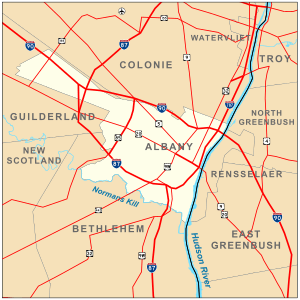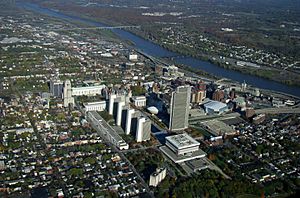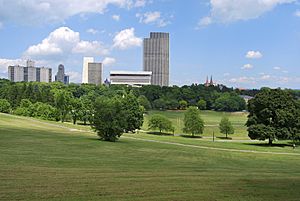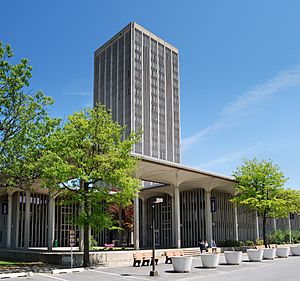Architecture of Albany, New York facts for kids
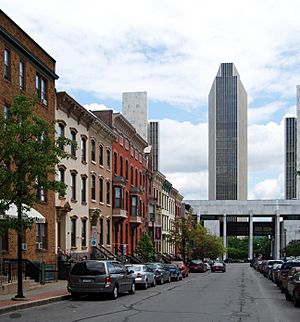
The architecture of Albany, New York, shows many different building styles. These styles range from the early 1700s to today. Albany started in the early 1600s, but not many buildings from that time or the 1700s and early 1800s are still standing. When the Erie Canal was finished in 1825, a lot of building happened. This continued until the Great Depression and when people started moving to the suburbs. This explains most of the buildings in the city center, near the Hudson River. Since then, most new buildings have been homes. The city grew to its current size. There are also some large government buildings in the modern style, like Empire State Plaza. This plaza includes the Erastus Corning Tower, which is the tallest building in New York State outside of New York City.
Because Albany is the capital of New York, many important buildings are government ones. Examples include the state capitol and city hall. The city also has many famous churches. These include All Saints and Immaculate Conception cathedrals. These are the main churches for the Episcopal and Roman Catholic faiths. Downtown has important business buildings, like the old headquarters of the Delaware and Hudson Railroad. This building is now the SUNY System Administration Building and is another symbol of the city. Most of Albany's old buildings are its many rowhouses. These are homes for people in rich areas like Center Square and poorer areas like Arbor Hill.
Many famous architects designed buildings in Albany. These include Philip Hooker, Patrick Keely, Andrew Jackson Downing and Calvert Vaux, Richard Upjohn and his son, Henry Hobson Richardson, and Stanford White. As New York's state architect, Isaac Perry and Lewis Pilcher did important work. Two local architects, Marcus T. Reynolds and Albert Fuller, built many key buildings in the early 1900s.
Much of Albany's important architecture is listed on the National Register of Historic Places. They are listed either alone or as part of its 14 historic districts. Almost all of the other 48 listed properties are buildings. Three buildings are even more special as National Historic Landmarks because of their amazing design. These are the state capitol, St. Peter's Episcopal Church, and the Schuyler Mansion. The mansion belonged to Revolutionary War officer and early U.S. Senator Philip Schuyler.
Contents
Exploring Albany's Layout and Landmarks
Albany is located along the Hudson River. Its main area is across from the smaller city of Rensselaer. The Dunn Memorial Bridge connects them. Major roads like Interstate 787 and Interstate 90 surround most of the city's developed parts. Beyond the Slingerlands Bypass, the city is mostly bordered by Normanskill Creek.
I-787 and railroad tracks separate the industrial waterfront from the rest of the city. The land gently rises 200 feet (60 m) to the west. This gives buildings a view of the river. This raised area used to have deep valleys with creeks. Most of these have been filled in as the city grew. Sheridan Hollow is an exception. It could not be completely filled. It still separates Arbor Hill and the 82-acre Tivoli Nature Preserve.
Downtown Albany: The City's Historic Heart
Downtown Albany is the oldest and most built-up part of the city. It is roughly where the city's first walled area was. It has tall buildings like the Home Savings Bank Building. Newer projects, like the Times Union Center arena, are also here. To the south are the first neighborhoods built as the city grew. These include the Mansion and Pastures areas. North of downtown, most buildings are along Broadway and North Pearl Street. This area has more parks and open spaces near the river.
Government Buildings and Empire State Plaza
Just west of downtown, at the top of the raised land, is the Lafayette Park Historic District. This area is known for two huge government buildings. These are the state capitol and the State Education Department building. Smaller buildings like city hall and the New York Court of Appeals building are also here. The Old Albany Academy Building is now the main office for the city's schools. The Cathedral of All Saints is also in this district. Several small parks with statues surround the capitol.
South of the capitol is Empire State Plaza. This is a group of state office buildings. Its five sleek, modern towers stand out in Albany. The Erastus Corning Tower is 589 feet tall. It is the tallest building in Albany and all of upstate New York.
On its south side, Empire Plaza is bordered by Madison Avenue. Across the street is the modern New York State Library. To its east are the two Gothic Revival spires of the Cathedral of the Immaculate Conception. This is the main church for the Roman Catholic Diocese of Albany. Just north of the cathedral is the Victorian governor's mansion. This mansion gives the nearby Mansion District its name.
Parks and Residential Areas
Lincoln Park is one of Albany's two main parks. It gently slopes down to the South End. This park has tennis and basketball courts and pools. The largest pool is 2 acres (8,000 m2). It is thought to be the largest cement pool in the Northeast. In the park's southeast corner is the small brick Italian villa-style James Hall Office. This is a National Historic Landmark.
West of the main government buildings, the land becomes flatter. Across from the capitol is the Art Deco Alfred E. Smith Building. This tall state office tower is part of the Center Square/Hudson–Park Historic District. This is a large residential area with many rowhouses. It stretches past Lark Street, which is a popular nightlife spot. It continues to Washington Park. This is the city's largest park, with an 81-acre area. Madison Avenue and State Street have older rowhouses built near the park. The SUNY at Albany downtown campus is also nearby.
The Park South neighborhood is another residential area with rowhouses. It includes the small Knox Street Historic District. This area is next to the large campuses of Albany Academy, Albany College of Pharmacy, Albany Law School, Sage College of Albany, and Albany Medical College. This is the center of the University Heights neighborhood. New Scotland Avenue leads to residential areas where rowhouses change to detached houses.
West of Washington Park is Pine Hills. This was one of the first neighborhoods to feel more like a suburb. It is mostly homes, except for the 48-acre campus of The College of St. Rose. There are also some shops along Madison and Western avenues. In the city's northwest, a large industrial park is next to the Tivoli Preserve. Central Avenue passes through a neighborhood with some larger apartment buildings. Then it becomes a big shopping area near I-90.
West of NY 85 is the 330-acre W. Averell Harriman State Office Building Campus. Its buildings are between two ring roads. Just beyond it is the main campus of SUNY Albany. It looks like Empire Plaza with four tall modern dorm towers. They are arranged in a square around a large central academic building. The campus also has a ring road. South of Western Avenue are newer residential neighborhoods. Between Washington Avenue and I-90 are hotels, restaurants, and gas stations.
In the city's western part, along I-90, is the small Rapp Road neighborhood. Artificial Rensselaer Lake is the city's largest body of water at 35.3 acres. It is east of the I-90 and Adirondack Northway junction. Excelsior College, the Pine Bush Preserve Discovery Center, and some small neighborhoods are in the open space of the Pine Bush.
From Albany, you can see the river to the east. Some Taconic foothills are visible from taller buildings. To the southwest is the long ridge of the Helderberg Escarpment. The unique ridgeline of the Blackhead Range in the northern Catskills is to the south. These are nearly 4000 feet high. On clear days, you can see the lower Adirondack foothills to the north. The Green Mountains of Vermont are to the northeast.
Albany's Architectural Journey Through Time
The first known building in Albany was a French fort in 1540. It was destroyed by floods. Then the Dutch built Fort Nassau in 1614. It was also destroyed. Finally, Fort Orange was built in 1624.
Albany's first buildings showed many Dutch styles. English styles followed soon after. The Quackenbush House, a Dutch Colonial brick mansion, was built around 1736. Schuyler Mansion, a 1765 Georgian mansion, was built for Philip Schuyler. He was an American general during the Revolutionary War. Later, he became a United States Senator. The mansion became a National Historic Landmark in 1979. The oldest building still standing in Albany is the Van Ostrande-Radliff House at 48 Hudson Avenue. Experts believe it was built in 1728.
Albany City Hall, a Richardsonian Romanesque building, was designed by Henry Hobson Richardson. It opened in 1883 and houses Albany's city government. The New York State Capitol opened in 1899. It took 32 years to build and cost $25 million. This made it the most expensive government building at that time. These two buildings were so famous that in 1885, American Architect and Building News called them among the top ten most beautiful buildings in the country. Albany's Union Station, a major Beaux-Arts design, was also being built then. It opened in 1900. People said that "perhaps no other building has been so important to the growth of Albany during the twentieth century as Union Station."
Albany's homes vary greatly. Older parts of town, closer to the river, have mostly row houses. The types of homes change like "ripples of housing styles radiating from downtown." Row houses are in the first ring. The second ring saw many two-family homes built in the late 1800s. Electric street cars served these homes. Cars made it possible to live even further from downtown. Outside the two-family home ring is a ring of one-family homes. These were first built after World War II and are still being built today.
The Washington Avenue Armory opened in 1891. It is a Romanesque Revival design. Its architect, Isaac Perry, was greatly influenced by Henry Richardson. Richardson had worked with Perry on the State Capitol. Today, the Armory is an entertainment place. In 1912, the Beaux-Arts style New York State Department of Education Building opened. It is on Washington Avenue near the Capitol. It has a classical outside with a long white marble colonnade. Later, in 1917, Albert W. Fuller's First Congregational Church of Albany was built. It was in the undeveloped Woodlawn neighborhood. It was the city's first building to use the new Colonial Revival style.
The 1920s brought the Art Deco style. Examples include the Home Savings Bank Building (1927) and the Alfred E. Smith Building (1930). These are two of Albany's tallest buildings. Philip Livingston Junior High School is an important building at the city's northern entrance. It combined Colonial Revival outside with Art Deco inside when it opened in 1932. In 1941, the Miss Albany Diner opened as "Lil's Diner." It is a classic "Silk City Diner" Art Deco design. Miss Albany is one of the few diners from before World War II that is still almost original.
Buildings from the 1960s and 1970s are common in Albany. The Empire State Plaza complex was built between 1965 and 1978. Governor Nelson A. Rockefeller and architect Wallace Harrison created it. It is a strong example of late American modern architecture. It was a debated project because it moved city residents. Its architectural style was also controversial. The most famous part of the complex is the Erastus Corning Tower. It is the tallest building in New York State outside of New York City.
At the other end of the city are two more large modern complexes. These are the W. Averell Harriman State Office Building Campus (1950s and 1960s) and the uptown campus of the University at Albany (1962–1971). The state office campus covers nearly 330 acres. It has over 7,000 employees in about 16 buildings. These buildings have about 3 million square feet of office space. It is a suburban-style campus, designed for cars. It is surrounded by a ring road that separates it from nearby neighborhoods. Governor W. Averell Harriman planned the state office campus in the 1950s. He wanted more parking and easier access for state employees. The first building was built in 1956. Most buildings were built in the 1960s under Governor Rockefeller.
The uptown SUNY campus was built in the 1960s under Governor Nelson Rockefeller. It was built on the site of the city-owned Albany Country Club. Unlike the open campus style of other universities, SUNY Albany has a central building layout. At its core is a large "podium" with academic and administrative buildings. Four dorm complexes are at each corner of the podium. Each has a tall housing tower surrounded by smaller support buildings. The architecture used a lot of concrete and glass. The style has thin, round-topped columns and pillars. These are similar to those at Lincoln Center in New York City.
Downtown Albany has become more lively in recent years. This change is often said to have started in 1986. That's when Norstar Bank renovated the old Union Station for its main office. The Times Union Center (TU Center) was once planned for the suburbs. Instead, it was built downtown and opened in 1990. The TU Center and the renovated Palace Theatre (2003) have made Pearl Street a fun area. It has many bars and restaurants. Downtown has also benefited from the Alive at 5 summer concerts. These happen at the Corning Preserve. Other new developments downtown include the Dormitory Authority headquarters (1998). The Department of Environmental Conservation building, with its green dome, opened in 2001. The State Comptroller headquarters opened in 2001. The Hudson River Way (2002) is a pedestrian bridge connecting Broadway to the Corning Preserve. In 2005, 677 Broadway became "the first privately owned downtown office building in a generation." A Hampton Inn & Suites also opened in 2005.


